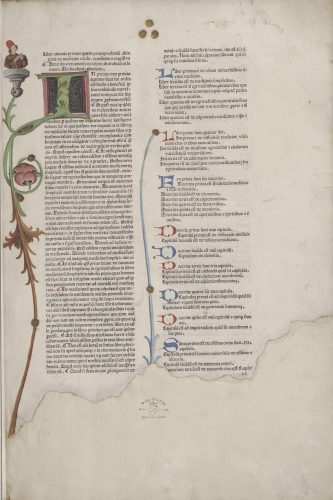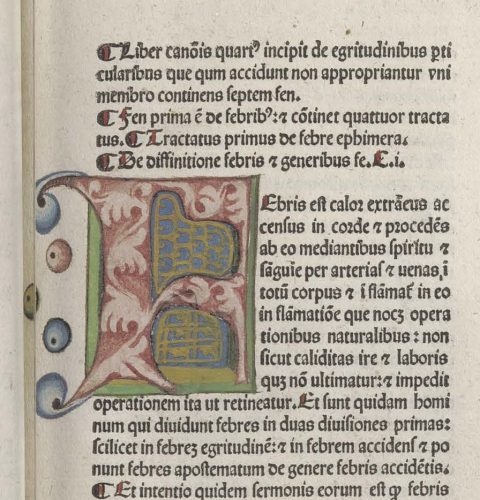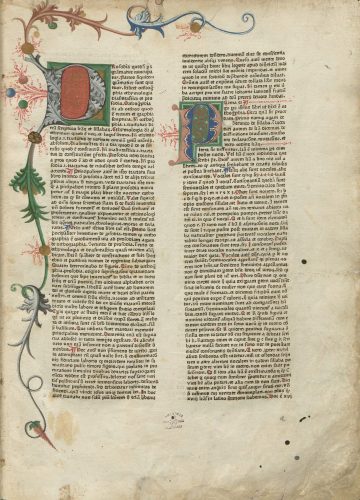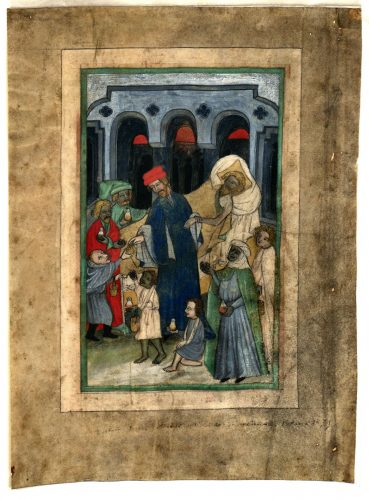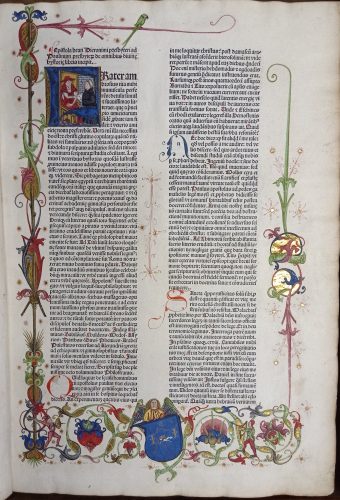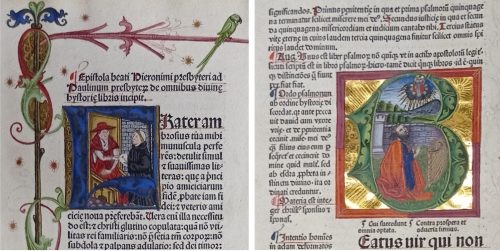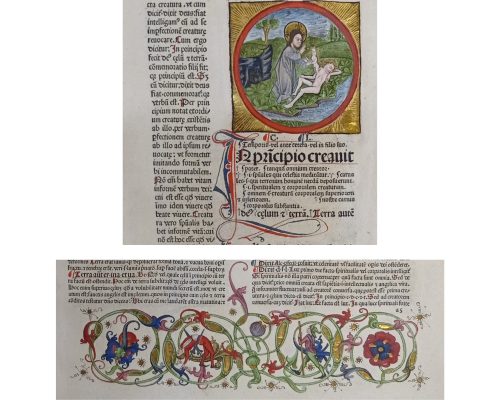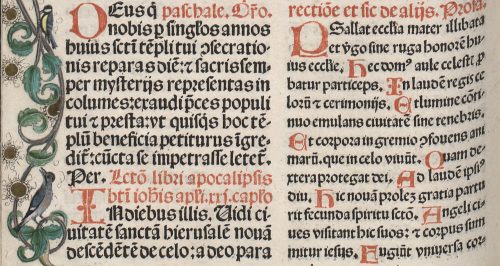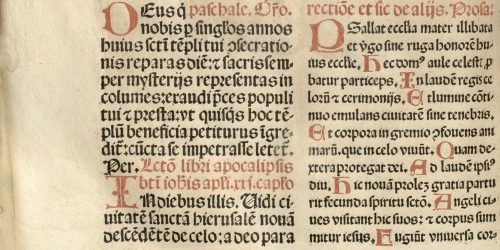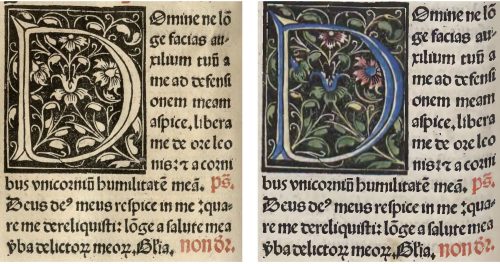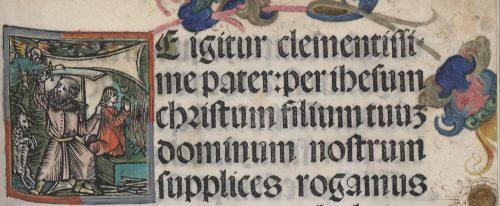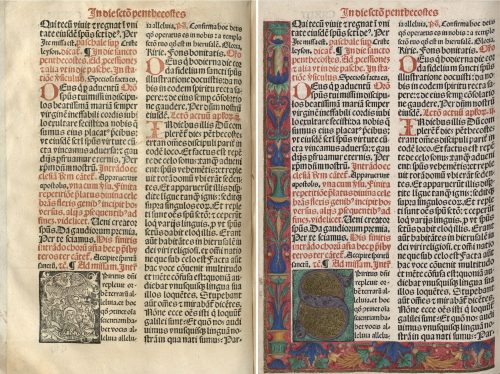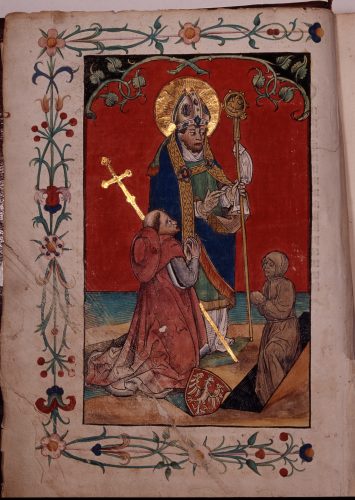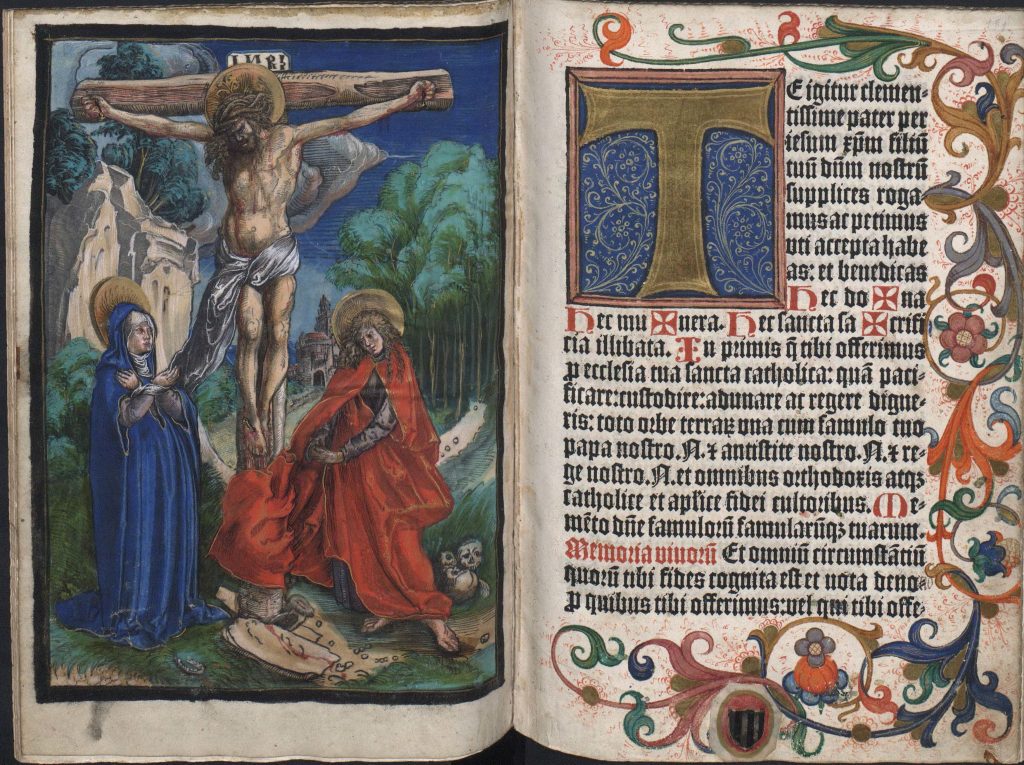Single-leaf woodcuts, printed separately from books, were known in Europe since the fifteenth century. The images, usually with additional text, were printed only on one side of the sheet of paper. It was a popular form of printing in German countries. Many Einblattholzschnitte were coloured, often with the use of stencils. It seems that single-leaf woodcuts were quite rare in Poland; it might be caused either by the lack of preserved examples or insufficient research on this issue.
Among numerous representations of Stefan Batory there is a group of images which show the king in a similar way. They represent the ruler as the Prince of Transylvania, in a characteristic attire. This schemata was introduced by an etching made by Jost Amman in 1576 and repeated later by painters and printers (Mrozowski 2021: 176). One of such repetitions was a colourful single-leaf woodcut, a half-length portrait of Batory, face three-quarter to the right.
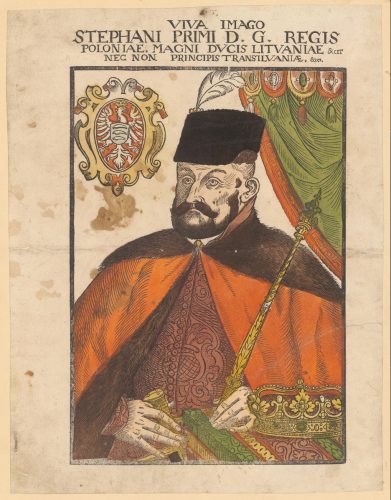
Four editions of this print have been mentioned in the literature so far: an unknown one from the National Library (Komornicki 1935: 24), another one from the collection of Johann Jacob Wick, which is held in the Graphische Sammlung of the Zentralbibliothek in Zürich (fig. 1, inv. no 000003583, Pirożyński 1993: 92-92; Pirożyński 1995: 294, cat. 14) and, finally, two prints which belong to Książnica Kopernikańska in Toruń (inv. no K. fol. 143, Pirożyński 1993: 93-94). The last two images are incomplete and each of them is cut into two pieces; one presents the left part of the composition (fig. 2) and the other one its right part (fig. 3). The bottom part is missing in both of them.
These two woodcuts are accompanied with fragments of inscription in Polish, which elicits the titles of the ruler: VIVA IMAGO Naiasnieiszego Pana a Pana Stephana pierwszego | z Bożey łaski Króla Polskiego | wielkiego Książęcia Litewskiego | Ruskiego | Pruskiego | Zmodz-kiego | Mazowieckiego | Infanckiego | Woiewody Siedmigrockiego. Etc. Almost identical inscription, but written in Latin, occurs on the exemplar from Zürich: VIVA IMAGO | STEPHANI PRIMI D. G. REGIS | POLONIAE, MAGNI DVCIS LITVANIAE & CET | NEC NON PRINCIPIS TRANSILVANIAE, &cet.

The composition, closed in a black frame, depicts the half-length figure of the ruler, three-quarters to the right. Batory is dressed in an elegant patterned robe, precisely a long linen garment called żupan, covered with delia – a garment which resembles a coat, with a collar made of fur. Kolpak, a headgear with a white feather, decorates his head. The king holds a sceptre in his left hand, while in the right one he carries the hilt of a sabre. On the left side there is a cartouche with the white eagle and the king’s coat of arms: three wolf’s fangs. The right part is closed by a curtain with pelmet and tassels.
All these elements refer to Batory as the Prince of Transylvania. Among the wide variety of dresses worn in the sixteenth-century Commonwealth of Poland, the king was depicted in the one which emphasised his Hungarian legacy. Although there was no one typical attire, Polish dresses were generally strongly influenced by Hungarian and oriental trends due to close connections with Hungary and the East during Batory’s reign as well as the idea of deriving Polish noblemen from the ancient Sarmatians (Ostrowski 2019: 271). Polish and Hungarian attire of that time had a lot in common. They were both derived from Turkey and stood in opposition to the Western fashion. Batory consciously chose to be represented in a way which would be associated with his Transylvanian roots and Hungarian connections.
All extant editions of the woodcut were coloured by hand, partially with the use of stencils, which is visible in the outer, red part of the coat, but also in the headgear and green surface of the curtain. The colours are limited to red, green, yellow, dusty pink, blue or light green and black or brown, depending on the edition. Generally, the location of colours is similar in all variants, but there are some differences in the part of cartouche, tassels and the visible fragment of hair. Furthermore, the hues differ slightly, especially in the part of fur, headgear, beard and moustaches, which are brown in the woodcut from Zürich and black in both prints from Toruń.
The questions of where and when were the woodcuts printed have not been solved yet. The one from Wick’s collection was thought to be printed in Nuremberg by Lucas Mayer active between 1566 and 1605, which is rather doubtful (Strauss 1975: 723, cat. 22). Another hypothesis links it with Cracow, the biggest centre of print production in the Commonwealth of Poland at that time. Bruno Weber suggested that the portrait could have been brought to Zürich by the humanist and theologian Krzysztof Trecy (ca. 1530-ca. 1590), who visited Switzerland eight times between 1567 and 1577 (Weber 2015: 90).
Nevertheless, it is assumed that the two woodcuts from Książnica were printed elsewhere. They were found in the cover of Eutropius’ Chronica (inv. no MAG 100020) printed by Melchior Nering, who was active in Poznań, but also Grodzisk Wielkopolski and Toruń (Kawecka-Gryczowa 1962: 282). When the book got to the collection this waste paper was taken out of its cover and restored. The connection between the book and discovered pieces of woodcuts resulted in associating them with Nering. The cover of Chronica was dated 1581 when the printer worked in Grodzisk. According to the researchers, these woodcuts were produced by Nering in Grodzisk either in 1579 (Komornicki 1935: 24) or between 1579 and 1581 (Kawecka-Gryczowa 1962, 282). Other hypotheses indicate that they were created in Toruń in the period between 1581 and 1587 in the printing house of Nering or Andrzej Koteniusz (Tujakowski 1970: 18; Jarzębowski 1969: 86).
Even if the question of place of production is unresolved, the issue of the portrait’s function seems to be obvious. Batory was known as the ruler who put strong emphasis on political propaganda. Such single-leaf woodcuts were presented in public places in the Commonwealth and served as a propaganda tool against the supporters of emperor Maximilian II, who was claimed as a king of Poland before Batory. Another example which evidences such function is a half-length portrait of the king, three-quarters to the right. The coat of arms, depicted next to the figure, is praised in a poem accompanying the print (Komornicki 1935: 18; Pirożyński 1992). The woodcut held in the Sächsische Staatsarchiv in Dresden might be the only existing example of this print (10697, no 64, 368-369). Again, it was coloured by hand.
Colours played an important role in this kind of formal portraits. They emphasised the meaning of each element; the coat of arms promoted Batory as a king, the sceptre recalled his function, while the sabre underlined his bravery. The latter referred to his affiliation to the noblemen, but was also a typical addition to Polish and Hungarian attire. The royal insignia, the sabre and the cartouche were painted yellow, which makes them more visible in comparison to the dark hues of other elements. If we assume that these woodcuts were hung on the walls in public places the fact that they were colourful made them very eye-catching.
Although the iconography of presented portraits seems to be quite typical for Batory’s images, the form of the print is rather exceptional in Polish context. If some of the sixteenth-century graphic portraits can be treated as the repetitions of paintings which do not exist anymore (Mrozowski 2021: 649-650), it is possible that these woodcuts belong to this group. They could also serve as patterns or, at least, as the source of motives for later painted or printed representations of Stefan Batory.
Quoted literature:
Jarzębowski, Leonard, 1969. Druki toruńskie XVI wieku. [The sixteenth-century prints from Toruń] Toruń: Państwowy Instytut Wydawniczy.
Kawecka-Gryczowa, Alodia, 1962. “Melchior Nering.” In: Drukarze dawnej Polski od XV do XVIII wieku [Printers in old Poland from the 15th- to the 18th-century], vol. 4, pp. 272-291.Wrocław, Kraków: Zakład Narodowy im. Ossolińskich, Wydawnictwo Polskiej Akademii Nauk.
Komornicki, Stefan, 1935. Essai d’une iconographie du roi Etienne Batory. Cracovie: Académie Polonaise des Sciences et des Lettres: Académie des Sciences Hongroise.
Mrozowski, Przemysław, 2021. Portret w Polsce w XVI wieku [The 16th-century portrait in Poland], Warszawa: Muzeum Pałacu Króla Jana III w Wilanowie.
Ostrowski, Jan K., 2019. Portret w dawnej Polsce [Portrait in old Poland], Warszawa: Muzeum Pałacu Króla Jana III w Wilanowie.
Pirożyński, Jan, 1992. “Plakat propagandowy na cześć Stefana Batorego wydany po jego elekcji (Ze zbiorów Archiwum Państwowego w Dreźnie)” [Propaganda poster printed in honour of Stefan Batory after his election (from the collection of the National Archive of Dresden)]. In: Roczniki Biblioteczne, vol. 42, pp. 129-135.
Pirożyński, Jan, 1993. “Kilka nieznanych lub mało znanych batorianów ze zbiorów Centralnej Biblioteki w Zurychu” [Few unknown or little known batoriana from the Central Library in Zürich]. Roczniki Biblioteczne, vol. 37, Wrocław: Państwowe Wydawnictwo Naukowe, pp. 83-103.
Pirożyński, Jan, 1995. Z dziejów obiegu informacji w Europie XVI wieku. Nowiny z Polski w kolekcji Jana Jakuba Wicka w Zurychu z lat 1560-1587 [The history of circulation of information in the 16th-century Europe. News from Poland in the collection of Johann Jacob Wick in Zürich between 1560 and 1587], Kraków: Uniwersytet Jagielloński, 1995.
Strauss, Walter L., 1975. The German single-leaf woodcut 1550-1600: a pictorial catalogue. Vol. 2, K-R. New York: Abaris Books.
Tujakowski, Alojzy, 1970. Z dziejów drukarstwa i piśmiennictwa na Pomorzu: 400 lat drukarstwa w Toruniu 1569-1969 [The history of printing and literature of Pomerania: 400 years of printing in Toruń 1569-1969], Warszawa: Ludowa Spółdzielnia Wydawnicza.
Weber, Bruno, 2015. “Eine Sammlung von Porträts. Variationen über das repräsentative Zur-Schau-Stellen”. In: Glanzlichter. Meisterwerke aus der Graphischen Sammlung und dem Fotoarchiv der Zentralbibliothek Zürich, Zürich: Zentralbibliothek Zürich, pp. 81-101.
